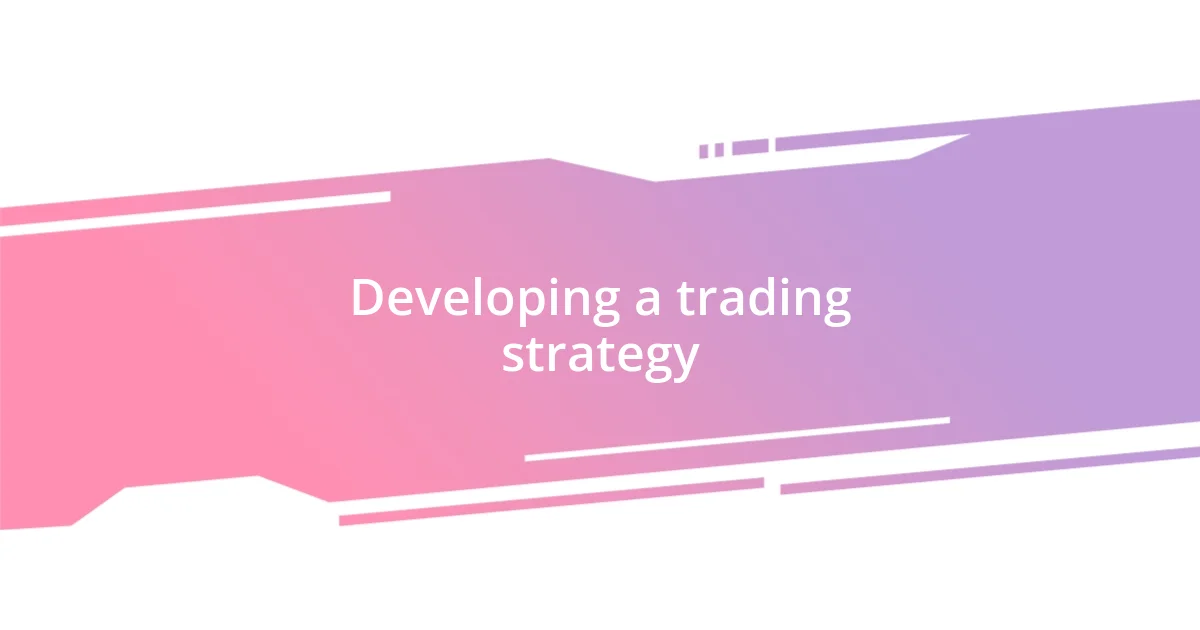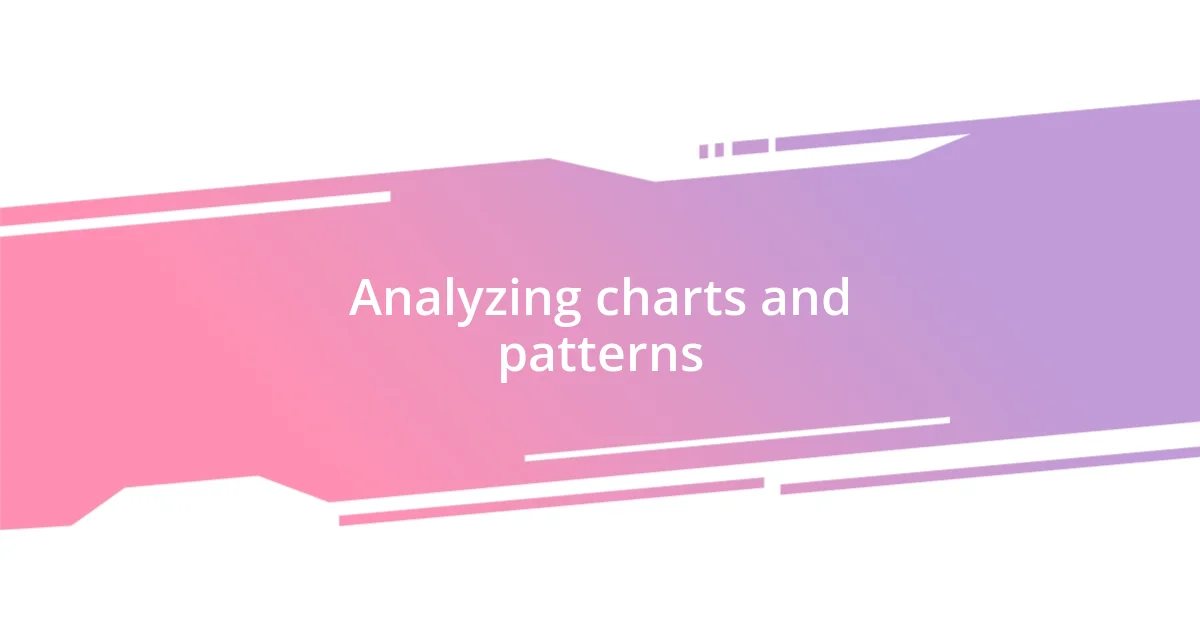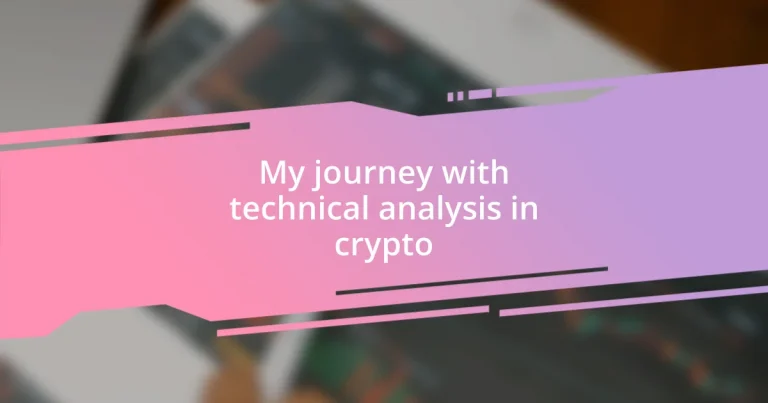Key takeaways:
- Mastering technical analysis involves understanding price patterns and developing market intuition, which can lead to informed trading decisions.
- Implementing a robust trading strategy with risk management techniques, such as position sizing and diversification, is essential for maintaining emotional control and minimizing losses.
- Continuous learning and adaptation, including engagement with the trading community and exploring new tools, are crucial for growth and success in the dynamic cryptocurrency landscape.

Introduction to technical analysis
Technical analysis, at its core, is like reading the market’s pulse. It involves analyzing price charts and other statistical indicators to forecast future movements. I remember when I first stumbled upon this methodology; it felt like unlocking a new layer of understanding in the chaotic world of crypto.
As I delved deeper, I began to appreciate how historical price patterns could reveal potential future trends. Have you ever noticed how certain price movements seem to repeat? It’s fascinating! This repetitive nature of price action can empower us to make informed decisions rather than relying on gut feelings alone.
In my experience, mastering technical analysis isn’t just about the tools; it’s about developing a keen intuition for the market. It’s almost like learning a new language that helps you communicate with the charts. Every candlestick tells a story, and I find it exhilarating to decode those stories into actionable strategies. What has your experience been with interpreting market signals?

Understanding cryptocurrency markets
Understanding cryptocurrency markets requires a keen eye on volatility and sentiment. From my experience, the emotional landscape can shift rapidly, leading to dramatic price movements in a matter of hours. I vividly recall a time when a tweet from a major influencer sent the market spiraling; it was a stark reminder of how external factors can shape our trading environment.
Price trends and patterns are crucial indicators for anyone looking to navigate these markets successfully. One day, while analyzing a double bottom formation on my favorite altcoin, I felt a rush of excitement—the signals were aligning, and I knew I had to act! This is what makes trading in crypto appealing; the ability to spot opportunities amidst chaos often feels like a thrilling game of chess.
I have learned that understanding these markets is as much about market psychology as it is about numbers. When I first started trading, I often overlooked how emotional reactions could influence price. Now, when I look at charts, I consider not just the technical indicators but also the collective mindset of traders and investors. It’s a blend of art and science that keeps me engaged every single day.
| Market Feature | Cryptocurrency |
|---|---|
| Volatility | High |
| Market Hours | 24/7 |
| Market Sentiment | Influential |

Choosing the right tools
Choosing the right tools for technical analysis in crypto is a game-changer. Initially, I felt overwhelmed by the sheer number of options available. After some trial and error, I found that focusing on a few reliable platforms made all the difference in my trading journey. It’s essential to choose tools that resonate with your trading style and preferences, as this can enhance your analytical skills and confidence.
Here are some key tools that I’ve found invaluable:
- TradingView: An intuitive charting platform that offers a vast array of indicators.
- CoinMarketCap: Excellent for tracking real-time prices and market capitalization.
- CryptoCompare: A comprehensive resource for historical data and comparisons across different coins.
- Binance or Coinbase: User-friendly exchanges that integrate basic charting features.
- Telegram Channels & Twitter: I often follow traders on these platforms for real-time insights and emotional context, which can be just as important as the charts.
I realize now that a well-chosen toolkit helps you build that intuitive connection with the market. Over time, your familiarity with these tools allows you to spot opportunities more quickly, giving you a competitive edge as you navigate the dynamic crypto landscape.

Developing a trading strategy
Developing a trading strategy is where the real art of trading comes to life. I remember the early days when I would jump in without a clear plan, only to feel lost in the chaos of the market. Over time, I learned that having a strategy not only provides direction but also helps manage emotions, especially when prices swing wildly. Have you ever experienced that moment when fear clouds your judgment? I have, and it’s those moments that made me realize a well-devised strategy is like a safety net.
I found that my strategy needed to encompass both technical indicators and a strong risk management framework. For instance, I decided to set a maximum loss limit on each trade. This practice has shielded me from the emotional turmoil of unexpected downturns. I still recall a time when I adhered to my stop-loss rules, which allowed me to mitigate losses even during a severe market drop. It was a relief to see my strategy at work, reinforcing my belief in its effectiveness.
Another key aspect of my trading strategy involves continuously revisiting and refining my approach. As the crypto landscape evolves, so should our strategies. I often review my trades to discern patterns in my successes and failures. This reflective practice not only sharpens my skills but also fosters personal growth in my trading journey. Have you taken time to evaluate your trading choices? Trust me, it can be eye-opening and incredibly beneficial for future endeavors.

Analyzing charts and patterns
One of my favorite parts of technical analysis is digging into charts and recognizing patterns. At first, I felt like I was staring at a foreign language, but over time, I began to see repeated shapes that hinted at future price movements. For instance, identifying a classic head and shoulders pattern was a pivotal moment for me—it was like flipping a switch in my understanding. Have you ever noticed a subtle pattern and felt that rush of excitement? That thrill is what keeps me coming back to the charts.
As I grew more comfortable with interpreting charts, I started layering different technical indicators. For example, combining moving averages with candlestick patterns offered me a clearer picture of market trends. I can’t forget the day I spotted a bullish engulfing pattern with strong volume support; it gave me the confidence to place a trade that turned out to be quite successful. The sense of accomplishment that followed was exhilarating—it’s moments like these that truly solidify my belief in the power of reading charts.
I’ve learned that no pattern is foolproof, and that’s where my emotional resilience comes into play. Watching a seemingly promising pattern break down can be disheartening, but I remind myself that the market is always in motion. I think back to instances when I got blindsided by unexpected reversals and how important it was to stick to my risk management principles afterward. How do you handle those emotional highs and lows? I find that a mindset focused on learning from each experience makes all the difference in my trading journey.

Risk management techniques
Risk management in trading is essential, especially in the volatile world of crypto. One technique I adopted was the use of position sizing. I started by determining the amount I was willing to risk on any given trade. For example, when I first began, I limited my losses to 1% of my total trading capital. This simple rule not only allowed me to stay in the game longer, but it also kept my emotions in check. Have you ever calculated how much a small margin can affect your overall portfolio? Trust me, it can be quite enlightening.
Another critical technique is diversification. Initially, I would put all my funds into a single asset, thinking it would yield the highest returns. However, after experiencing a harsh lesson during a market downturn, I realized that spreading my investments across different cryptocurrencies helped cushion the blow. I can still remember the day when Bitcoin plummeted, but because I had also invested in altcoins, my overall losses were significantly reduced. How do you approach holding multiple assets? I believe that diversification can be a safety net, offering balance and reducing the risk of total loss.
Lastly, keeping a close eye on market trends and news is vital for managing risks effectively. I recall a time when I ignored a significant regulatory announcement. The aftermath was a sobering reminder of the power of geopolitical factors. From that day on, I made it a point to stay informed and adjust my trades accordingly. Have you ever felt blindsided by news that affected your trades? By integrating market awareness into my risk management strategy, I’ve evolved as a trader, adapting my approach to stay ahead in this fast-paced environment.

Continuous learning and adaptation
Continuous learning is at the heart of my journey in technical analysis. I often find myself revisiting old charts with fresh eyes, uncovering insights that I missed the first time. It’s like solving a puzzle, and each piece of new knowledge adds depth to my understanding. Have you ever looked back on your work and realized you had so much more to learn? It can be humbling, yet incredibly rewarding to see how far I’ve come.
Adapting to new strategies has also been a crucial part of my growth. During a particularly volatile market phase, I experimented with the Fibonacci retracement tool, which initially felt out of my comfort zone. But once I started to see how these numerical relationships played out on the charts, a whole new world opened up for me. It’s fascinating how something I once found complicated became an essential part of my toolkit. How do you approach unfamiliar concepts in trading? Embracing discomfort can lead to profound breakthroughs.
Finally, staying engaged with the trading community has significantly enriched my learning experience. Participating in forums and webinars introduced me to different perspectives and techniques that I hadn’t considered. I distinctly remember attending a workshop where a seasoned trader shared their approach to market sentiment analysis. It inspired me to incorporate sentiment analysis into my trading, allowing me to take a step back and assess the bigger picture. Have you ever had a conversation that transformed your approach? Continuous evolution in learning not only sharpens my skills but also fuels my passion for this ever-changing landscape.














